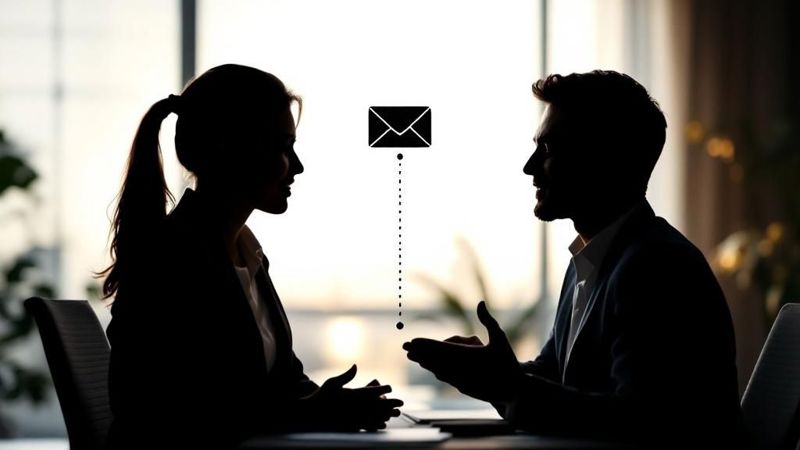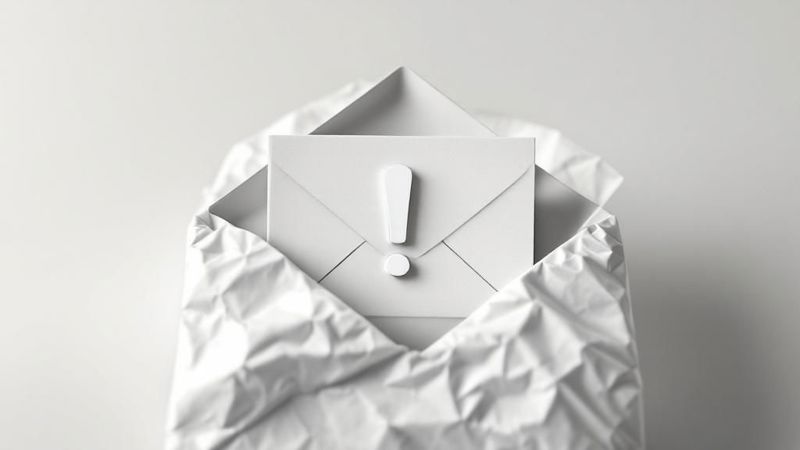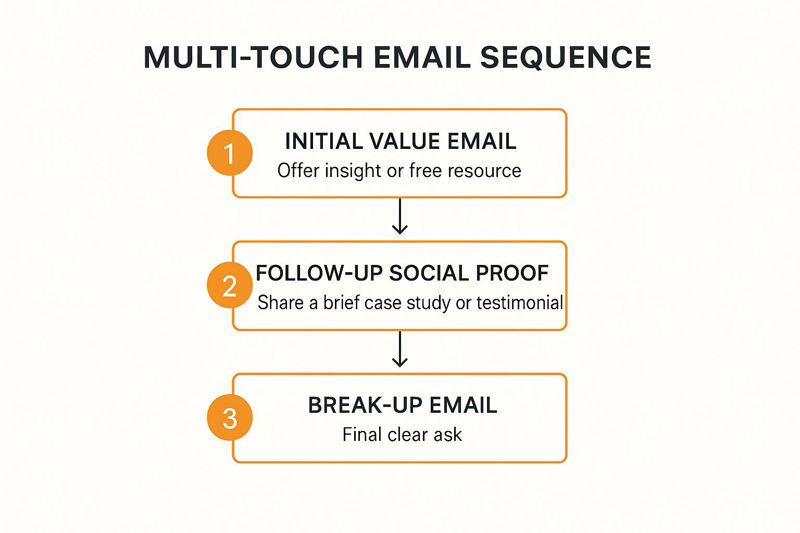In a world of overflowing inboxes, getting your cold email opened, let alone answered, is a monumental task. Generic templates and lazy outreach are dead. The new currency is hyper-personalization, genuine value, and strategic psychology. This guide isn't just another list of templates; it's a deep dive into the anatomy of effective outreach. We will dissect battle-tested cold emailing examples, revealing the tactical frameworks behind their success.
You'll learn not just what to write, but why it works. This empowers you to move beyond simple copy-paste and instead craft compelling messages that command attention and start meaningful conversations. The most effective cold emails, like all powerful marketing messages, leverage the art of storytelling in marketing to resonate with the reader on a human level.
We will break down several high-impact strategies, including:
- The Value-First Email (Problem-Agitate-Solve)
- The Mutual Connection Referral Email
- The Social Proof and Case Study Email
- The Pattern Interrupt Email
Each example comes with a complete analysis of its structure, personalization tactics, and psychological triggers. By the end, you will have a replicable system for creating cold emails that don't get ignored.
1. The Value-First Email (Problem-Agitate-Solve)
This approach, popularized by sales leaders like Jeb Blount and Aaron Ross, flips the traditional cold email on its head. Instead of immediately asking for a meeting, it focuses on delivering upfront value. The strategy is built on the classic Problem-Agitate-Solve (PAS) copywriting formula, where you identify a likely pain point, emphasize its negative impact, and then introduce your service as the clear solution. This method is one of the most effective cold emailing examples because it builds trust and positions you as a helpful expert, not just another salesperson.

Strategic Breakdown
The core principle is simple: give before you ask. By leading with a valuable insight, a free resource, or a relevant observation, you earn the recipient's attention. For this to work, your research must be specific. Generic statements won't cut it. You need to connect a specific business challenge to a tangible, negative outcome.
Key Insight: The "agitate" step is crucial. Don't just state the problem; briefly explain why it's a problem. For example, instead of saying "Your website loads slowly," say "Your website's 5-second load time could be losing up to 40% of potential customers before they even see your products."
Example in Action
Let's imagine a cybersecurity firm targeting a mid-sized e-commerce company.
Subject: A quick thought on [Prospect Company]'s data security
Problem (P): Hi [First Name], I noticed your privacy policy doesn't mention compliance with the new CPRA regulations.
Agitate (A): Companies not in compliance are facing fines starting at $2,500 per violation, which can add up quickly with customer data.
Solve (S): We recently helped [Similar Company] become fully compliant in under a week. I've put together a brief checklist of the key CPRA requirements for e-commerce sites. Would you like me to send it over?
Why This Example Works
This template succeeds because it's hyper-relevant and non-threatening. It identifies a specific, verifiable issue (the privacy policy) and attaches a real business risk (fines) to it. The call-to-action is low-commitment; it offers more value (a checklist) instead of demanding a 15-minute call. Mastering this approach is key to understanding how to write emails that people will actually read. By leading with generosity, you open the door for a genuine business conversation.
2. The Mutual Connection Referral Email
This is the fastest way to turn a cold outreach into a warm conversation. Championed by sales experts like Jill Konrath and central to LinkedIn's own sales methodology, this approach leverages a shared relationship to instantly build credibility. By mentioning a mutual connection, you borrow their trust and immediately differentiate yourself from a completely unknown sender. This technique is one of the most powerful cold emailing examples because it bypasses the initial skepticism most prospects have, making them significantly more likely to open, read, and respond.

Strategic Breakdown
The principle here is transferred trust. A recommendation from someone the prospect knows and respects is social proof in its most potent form. The key is to make the connection feel genuine and not forced. This requires getting explicit permission from your mutual contact before reaching out, ensuring they are comfortable with the introduction.
Key Insight: The subject line is your greatest asset here. Lead with the referrer's name to immediately capture attention. A subject like "Intro from [Mutual Connection's Name]" or "[Mutual Connection's Name] suggested I reach out" is far more compelling than a generic one.
Example in Action
Let’s say a marketing consultant wants to connect with a VP of Marketing, and they share a former colleague as a mutual connection.
Subject: [Mutual Connection's Name] suggested I get in touch
Opener: Hi [First Name], I'm reaching out because our mutual connection, [Mutual Connection's Name], recommended I connect with you.
Context: We worked together at [Previous Company], and when I mentioned I was helping SaaS companies like yours boost their MQL to SQL conversion rates, she immediately thought of you and the great work you're doing at [Prospect Company].
Value & CTA: I have a few specific ideas on how you could apply a similar strategy to your current funnel. Are you open to a brief 15-minute chat next week to discuss them?
Why This Example Works
This email is effective because it’s built on a foundation of familiarity. It immediately establishes a common ground and validates the reason for the outreach. The email is concise, respects the prospect's time, and clearly states the value proposition without being overly aggressive. By getting straight to the point and leveraging a trusted name, you transform a cold interruption into a welcome referral, dramatically increasing your chances of starting a meaningful business relationship.
3. The Compliment and Question Email
This classic technique, rooted in Dale Carnegie's timeless principles and championed by modern sales experts like Sujan Patel, leverages a fundamental aspect of human psychology: people appreciate sincere recognition. Instead of leading with a pitch, you start with a genuine, specific compliment about the recipient's work or a recent company achievement. This builds immediate rapport and disarms the natural skepticism associated with cold outreach, making it one of the most effective cold emailing examples for relationship-building.
Strategic Breakdown
The goal here is to shift the dynamic from a sales pitch to a peer-to-peer conversation. A well-researched compliment shows you’ve done your homework and aren't just blasting a generic template to a list. Following it up with a smart, relevant question demonstrates genuine curiosity and positions you as a thoughtful contemporary, not just a vendor. The key is authenticity; a generic "I love your blog" is easily ignored, but a specific compliment is not.
Key Insight: The question you ask is as important as the compliment. It should be open-ended and directly related to the compliment, prompting a thoughtful response rather than a simple "yes" or "no." This invites dialogue and naturally opens the door for a deeper conversation.
Example in Action
Let's imagine a marketing consultant reaching out to a Head of Content at a fast-growing SaaS company.
Subject: Loved your recent article on [Topic]
Compliment: Hi [First Name], I just finished reading your article in [Publication] about scaling content production. Your point about integrating user-generated content into the top-of-funnel strategy was brilliant and not something I've seen many others discuss.
Question: I'm curious, as you began implementing this, what was the biggest unexpected challenge in maintaining brand voice consistency with content from so many different sources?
Why This Example Works
This email works because it is ego-bait in the best sense of the word. It's respectful, specific, and intelligent. The compliment validates the recipient's expertise, and the question shows you’ve engaged with their ideas on a deeper level. The call-to-action isn't a meeting request; it's a request for their insight, which is far more likely to get a response. This human-centric approach transforms a cold email into a warm introduction, laying the groundwork for a future business relationship built on mutual respect.
4. The 'Before You Delete This' Email
This bold approach, championed by modern sales leaders like Morgan J. Ingram, tackles the recipient's skepticism head-on. It uses transparency and a touch of reverse psychology to disarm the reader, acknowledging that you know their inbox is crowded and they're likely to hit delete. By doing so, you create a moment of intrigue that compels them to keep reading. This method is a powerful cold emailing example because it breaks the pattern of typical sales pitches and establishes an honest, direct tone from the very first line.
Strategic Breakdown
The core strategy is to acknowledge the interruption you're creating. Instead of pretending your email isn't unsolicited, you lean into it. This candor can be surprisingly effective, but it must be immediately followed by a clear and compelling value proposition. If you use a bold opening, the reason for the email must justify it.
Key Insight: This approach works best when targeting busy, senior-level decision-makers (like executives or directors) who receive dozens of cold emails daily. They appreciate directness and are more likely to respect a sender who acknowledges the reality of their inbox.
Example in Action
Let's imagine a marketing agency contacting a busy Chief Marketing Officer (CMO).
Subject: Before you delete this, [Prospect Company]...
Acknowledge: Hi [First Name], I know you probably get a hundred emails like this a week, so I'll be quick.
Provide Value: Your recent campaign on LinkedIn was brilliant, but I noticed your landing page's conversion rate might be getting held back by its mobile layout. On my screen, the CTA button was below the fold.
Clear Ask: I made a 30-second video showing the quick fix we used for [Similar Company] that boosted their mobile conversions by 18%. Can I send you the link? No strings attached.
Why This Example Works
This email succeeds by combining honesty with hyper-specific value. The subject line creates immediate curiosity. The opening line builds rapport by showing empathy for the recipient's busy schedule. Most importantly, the value proposition isn't a generic claim; it's a specific observation tied to a tangible outcome (18% conversion boost). The low-friction call-to-action, offering a helpful video instead of demanding a meeting, makes it easy for the CMO to say yes and see you as a problem-solver.
5. The Pattern Interrupt Email
This bold technique, rooted in direct response marketing principles from figures like Dan Kennedy, is designed to do one thing: jolt the reader out of their inbox-scanning trance. The Pattern Interrupt Email deliberately breaks the conventional rules of professional communication. It uses unexpected subject lines, jarring opening sentences, or unusual formatting to force the recipient to stop, pay attention, and question what they're reading. In a sea of predictable sales pitches, this approach is a powerful way to stand out.

Strategic Breakdown
The core principle is to disrupt expectations. Our brains are wired to filter out familiar patterns, like a subject line that reads "Introductory Call" or an email starting with "Hope you're having a great week." By introducing something completely unexpected, you bypass this filter. The key is to quickly pivot from the disruption to your core value proposition, so the reader understands why you took such an unusual approach.
Key Insight: A pattern interrupt must be followed by genuine substance. The shock value earns you a few seconds of attention; what you say next determines whether you get a reply or get marked as spam. Don't be weird just for the sake of being weird; connect the interrupt directly to the problem you solve.
Example in Action
Let's imagine a sales training consultant targeting a struggling sales manager.
Subject: Your Q3 numbers
Opening Line: Hi [First Name], you can ignore this email.
The Pivot: Most people do. But the sales managers who don't are usually the ones tired of seeing their top reps miss quota by 15-20% month after month. They're frustrated that their current coaching method isn't closing the gap.
The Solve: We helped the team at [Similar Company] boost their close rate by 22% in 60 days by overhauling their discovery call script. I've attached a one-page breakdown of the framework they used. Worth a look?
Why This Example Works
This email is effective because the interrupt ("ignore this email") is counterintuitive and creates immediate curiosity. It then quickly pivots to a highly specific pain point (missing quota by 15-20%) that a sales manager would feel deeply. The call-to-action is low-friction, offering a valuable resource instead of demanding a meeting. This is one of the more advanced cold emailing examples, and when used correctly, it can break through to even the most guarded prospects by demonstrating confidence and a deep understanding of their world.
6. The Multi-Touch Sequence Email
This strategy, championed by industry leaders like Aaron Ross and methodologies from platforms like Outreach.io, moves beyond a single email to a coordinated campaign. A multi-touch sequence is a series of 5-8 emails sent over several weeks, where each message builds upon the last. This approach recognizes that most prospects won't reply to the first email, so it uses persistence and varied angles to nurture the relationship and stay top-of-mind. This is one of the most powerful cold emailing examples for complex sales with longer decision-making cycles.
This process flow infographic illustrates the three core stages of a simple but effective multi-touch sequence.

The sequence transitions from providing general value to building credibility with social proof and finally making a clear, direct request.
Strategic Breakdown
The core principle is persistent, patient, and value-driven follow-up. Instead of sending the same "just checking in" email repeatedly, each touchpoint offers a new piece of value, a different insight, or a unique call-to-action. The goal is to build a narrative over time, demonstrating your expertise and relevance from multiple angles.
Key Insight: The sequence isn't just about sending more emails; it's about varying the content. One email might offer a link to a blog post, the next might mention a relevant case study, and a third could reference a social media post they made. This diversity keeps the interaction from feeling like automated spam.
Example in Action
Let's imagine a consultant targeting an enterprise-level marketing director over a three-week period.
Email 1 (Day 1 - Value): Subject: Idea for [Prospect Company]'s content strategy
- Hi [First Name], I saw your recent post on LinkedIn about scaling content. I've attached a one-page framework we used to help [Similar Company] double their organic traffic in 6 months. Happy to share how it works.
Email 2 (Day 4 - Social Proof): Subject: Re: Idea for [Prospect Company]
- Hi [First Name], Following up on my last email. This framework was central to a project where we achieved a 150% ROI for a client in your industry. You can see the full case study here if you're curious.
Email 3 (Day 10 - Breakup): Subject: Closing the loop
- Hi [First Name], I haven't heard back, so I'll assume this isn't a priority right now. If you ever decide to re-evaluate your content strategy, please feel free to get in touch. All the best.
Why This Example Works
This sequence succeeds because it respects the prospect's time while demonstrating persistent value. Each message is short, relevant, and builds on the previous one without being pushy. The final "breakup email" is a professional way to close the conversation, often prompting a reply from prospects who were simply busy. To dive deeper into structuring these campaigns, you can explore these powerful email drip campaign examples. This methodical approach is ideal for high-value B2B sales where trust and relationship-building are paramount.
7. The Social Proof and Case Study Email
This email leverages one of the most powerful principles of persuasion: social proof. Popularized by Robert Cialdini's work on influence and adopted by sales leaders at HubSpot and Salesforce, this approach leads with results. Instead of talking about what you can do, you show what you have already done for a similar company. By using compelling case studies, testimonials, or data, you build instant credibility and de-risk the decision for the prospect. This is one of the most reliable cold emailing examples because it shifts the focus from promises to proven outcomes.
Strategic Breakdown
The core principle here is validation through relevance. People trust their peers more than they trust a salesperson. By presenting evidence that a company just like them achieved a desirable result using your solution, you create a powerful "fear of missing out" (FOMO) and a clear path to success. The key is to make the connection between the case study and the prospect’s own situation explicit and undeniable.
Key Insight: Don't just name-drop. Quantify the results. Instead of saying, "We helped Acme Corp with their marketing," say, "We helped Acme Corp, another B2B SaaS in the fintech space, increase their MQL-to-SQL conversion rate by 32% in Q3." Specific, measurable results are far more persuasive.
Example in Action
Let's imagine a marketing agency targeting a direct-to-consumer (DTC) brand.
Subject: Re: [Similar Company]'s 2.5x ROAS
Social Proof: Hi [First Name], I was just looking at the results from our recent campaign with [Similar Company], another DTC apparel brand, and I thought of you. We helped them achieve a 2.5x return on ad spend in their first 60 days.
Connecting the Dots: Their main challenge was scaling their Facebook ads profitably, which I imagine is a priority for you as well given your recent product launch.
Solve/CTA: We put together a short case study breaking down the exact strategy we used. Would you be open to me sharing the one-page summary?
Why This Example Works
This email is effective because it’s grounded in reality and speaks directly to the prospect's bottom line. The subject line is intriguing and result-oriented. It immediately establishes authority by referencing a specific, successful outcome for a peer company. The call-to-action is low-friction, offering valuable insight (the case study) rather than demanding a meeting. This tactic is a cornerstone of effective outreach, as successful personalized email marketing relies on demonstrating a true understanding of the recipient's world and challenges.
7 Cold Email Strategies Comparison
| Email Approach | 🔄 Implementation Complexity | ⚡ Resource Requirements | 📊 Expected Outcomes | 💡 Ideal Use Cases | ⭐ Key Advantages |
|---|---|---|---|---|---|
| The Value-First Email (Problem-Agitate-Solve) | High - requires research and customization | High - time-intensive insight creation | Moderate response (15-25%), builds trust | B2B sales, consulting, agencies, SaaS companies | Builds credibility & trust, high response rate |
| The Mutual Connection Referral Email | Medium - depends on existing relationships | Medium - requires network leverage | High response (40-60%), warm introductions | Relationship-based sales, high-value B2B deals | Immediate trust, easier meetings |
| The Compliment and Question Email | Medium - needs significant research | Medium - focused personalization | Moderate response (20-35%), personal engagement | Executives, thought leaders, competitive industries | Personal, low-pressure, positive response |
| The 'Before You Delete This' Email | Low - straightforward but tone-sensitive | Low - brief value-driven message | Moderate response (10-25%), attention-grabbing | Tech sales, modern B2B, younger decision makers | Honest, memorable, breaks email fatigue |
| The Pattern Interrupt Email | High - creative and careful execution | Medium to High - creative content | Variable response (8-30%), high open rates | Creative industries, startups, disruptive tech | Creative, stands out, memorable |
| The Multi-Touch Sequence Email | Very High - complex multi-step planning | High - requires automation & tracking | High cumulative response (25-45%), relationship nurturing | Long sales cycles, enterprise sales, high-value services | Persistence, multiple touchpoints, builds trust |
| The Social Proof and Case Study Email | Medium - sourcing and tailoring proof | Medium - strong case study library | Moderate response (18-28%), builds credibility | Established companies, risk-averse industries | Proven results, reduces risk perception |
From Examples to Execution: Your Next Steps
We've explored a diverse set of high-impact cold emailing examples, moving from the foundational Value-First approach to the attention-grabbing Pattern Interrupt. Each template serves as more than just a script; it’s a strategic blueprint designed to forge a connection where none existed. The core lesson across all these examples is that successful cold outreach is not a numbers game of brute force. Instead, it’s a sophisticated blend of empathy, strategy, and relentless personalization.
The most effective emails feel personal because they are personal. They demonstrate genuine research, address a specific pain point, and offer tailored value. The goal is to transform your message from an interruption into a welcome opportunity.
Distilling the Core Principles
To truly master the art of the cold email, let's distill the strategic pillars that support every successful example we’ve covered:
- Lead with Recipient-Centric Value: Your first sentence should immediately signal what's in it for them, not what you want from them. Whether it's a compliment, a relevant insight, or a solution to a problem, the focus must be on the recipient.
- Personalize Beyond the Name Tag: True personalization goes deeper than
[First Name]. It involves referencing their recent work, a mutual connection, a company achievement, or a challenge specific to their industry. This proves you’ve done your homework. - Clarity and Brevity are Paramount: Your prospect is busy. Your email must be scannable and easy to understand. Use short sentences, break up text, and get straight to the point. A clear, concise call to action is essential.
- Adopt a Human Tone: Write like you speak. Avoid corporate jargon and stiff, overly formal language. A conversational and authentic tone builds rapport and makes you more approachable.
Your Action Plan for Implementation
Knowledge without action is just potential. To turn these cold emailing examples into a powerful engine for your business, you need a clear implementation plan. Start small and build momentum.
- Select and Adapt One Template: Don’t try to implement all seven strategies at once. Choose the one template that most closely aligns with your immediate goal and target audience. Adapt it with your unique value proposition and voice.
- Define Your Measurement for Success: What does a "win" look like? Is it a reply, a booked meeting, or a demo request? Establish your key performance indicators (KPIs) like open rate, reply rate, and conversion rate before you send the first email.
- Integrate and Track Your Efforts: Manually sending and tracking outreach is inefficient and prone to error. To maximize the impact of your cold email campaigns, integrating your outreach with an effective CRM system is crucial for managing leads and tracking interactions. This allows you to monitor your performance, follow up systematically, and understand what's working at a glance.
- Test, Iterate, and Refine: Your first draft will not be your best. Send a small batch of emails and analyze the results. Tweak your subject line, your opening sentence, or your call to action based on the data. Continuous, data-driven iteration is the secret to long-term success.
Ultimately, the powerful cold emailing examples shared in this guide are your starting blocks. The real race is won through consistent application, thoughtful testing, and a commitment to providing genuine value in every inbox you land in.
Ready to make your cold emails impossible to ignore? OKZest helps you stand out by embedding dynamically personalized images directly into your emails. Imagine sending a pitch with the prospect's website screenshot already marked up with your suggestions. See how visual personalization can transform your outreach and start your free trial at OKZest today.